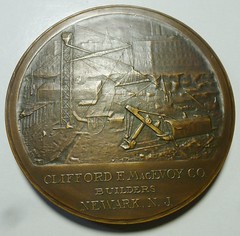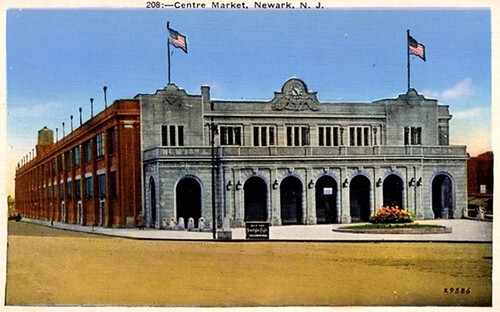
PREV ARTICLE
NEXT ARTICLE
FULL ISSUE
PREV FULL ISSUE
THE NEW CENTRE MARKET MEDAL
Harry Waterson published a nice article in the January 2016 issue of The Clarion from the Pennsylvania Association of
Numismatists. It describes the very interesting background of a medal commemorating a building in Newark, NJ. With permission, here is an
excerpt. -Editor
This medal is a joke! It is also a complicated medal with a complicated story. First the medal: 

Obverse: Two figures to the left, the goddess Minerva, dressed in a flowing garment points out a large building in the distance to her shorter companion, a nude Mercury who is pointing to an open scroll at his feet. The scroll is supported by a laurel branch and depicts a standing figure before a desk with another seated behind it. There is a 3-line inscription on-center in exergue: NEW CENTRE MARKET / NEWARK, N.J. / 1923. A small KILENYI hugs the rim at 8 o'clock. Reverse: Scene of heavy construction on a site divided by a canal with a steam shovel and a crane especially rigged for the pouring of concrete, all within a narrow raised rim. In exergue is a 3-line inscription on-center: CLIFFORD F. MACEVOY CO. / BUILDERS / NEWARK, N.J. There is a small J. HANSEN just inside the raised rim at around 8:30. Edge: J. F. NEWMAN, INC. N.Y. BRONZE Size: 2½-inches in diameter. And then the story: The City of Newark, NJ acting as its own general contractor put the New Centre Market out for bid in 1921. Clifford F. MacEvoy Construction was the low bidder for the general construction work of the building. The company bid $707,000 which was $114,000 less than the next bid. Seven companies had bid on the job. MacEvoy quickly checked his numbers and found that he had left out one entire page of calculations. In fact, if he had included the numbers on the missing page in his final sums, his bid would have been $118,000 higher and he would have lost the job by $4,000. MacEvoy sought to be relieved from his bid and he appeared before the Newark Board of Commissioners on September 19, 1921 to testify to that effect. He said he made an honest mistake while under serious family stress. His first wife had died in childbirth in 1918 and his second wife was currently undergoing a similarly difficult pregnancy. The board acknowledged the facts of the case but refused to waive the bid citing precedent and their civic duty to the tax payer. The Board voted 4 to 1 to tender the contract to the MacEvoy Company for execution. Clifford MacEvoy could have appealed this decision but obviously did not since he broke ground for the building just three months later on January 12, 1922. MacEvoy had to find a way to build the market within the strictures of his low bid. There is an article in a contemporary engineering journal that cites MacEvoy's specially designed hoisting equipment that allowed him to pour the concrete for the first half of the building in just three weeks. The article commends the efficiency of the concreting plant MacEvoy had devised. It was this that got the job done within the bid. Even the 1923 Manual of the Board of Commissioners stated "During the construction of the building the Clifford F. MacEvoy Company, contractors, established a record for such work by pouring 760 cubic yards of concrete in ten hours. Special aerial machinery was used to speed the handling of the concrete and other materials." 
The New Centre Market, 88 Mulberry Street, Newark, NJ. was built by the City of Newark with money raised through bond issues. It was operated by the Department of Parks and Public Property. The architects were Frank Grad and George B. Hooper. Frank Grad (1882-1968). On January 12th, 1924 two years to the day after first breaking ground on the site, Clifford MacEvoy hosted a private inspection of the New Centre Market for 500 invited guests. MacEvoy conducted a tour of the new market building after a buffet lunch. Each guest received an example of the medal as a keepsake of the occasion and as a record of events. The medal slyly refers to Clifford MacEvoy's problems with the Newark City Commission. On the obverse the piece of paper fallen to the ground is the missing bid sheet. The paper depicts a softly modeled scene of the company secretary standing with his arms in the air in front of the builder seated at a desk covered with plans for the building. This is the moment when MacEvoy learns the bid was too low. His numbers were wrong. One of the bid sheets had fallen to the floor. Arg! There is a arm and hammer raised in the air. All is not well! Minerva and Mercury are the main focus of the obverse to indicate that wisdom and speed are the solution to the low bid crisis and the successful completion of the building in the sky just above their heads. Julio Kilenyi sculpted this obverse and it is doubtful he did this composition in just one take. The reverse shows how MacEvoy did it with a careful rendering of the innovative concrete hoist and chutes he conceived to do the job. The crane, located in the center of the site, towered 180 feet in the air, exceedingly high for a building that was only going to be 30 feet tall. It allowed him to raise the concrete 80 feet in the air and then direct it via chutes anywhere on the 2-acre footprint of the market site from that one location. V. Joan Hansen sculpted the reverse. For more information about the Pennsylvania Association of Numismatists, see:
Wayne Homren, Editor The Numismatic Bibliomania Society is a non-profit organization promoting numismatic literature. See our web site at coinbooks.org. To submit items for publication in The E-Sylum, write to the Editor at this address: whomren@gmail.com To subscribe go to: https://my.binhost.com/lists/listinfo/esylum All Rights Reserved. NBS Home Page Contact the NBS webmaster 
|
